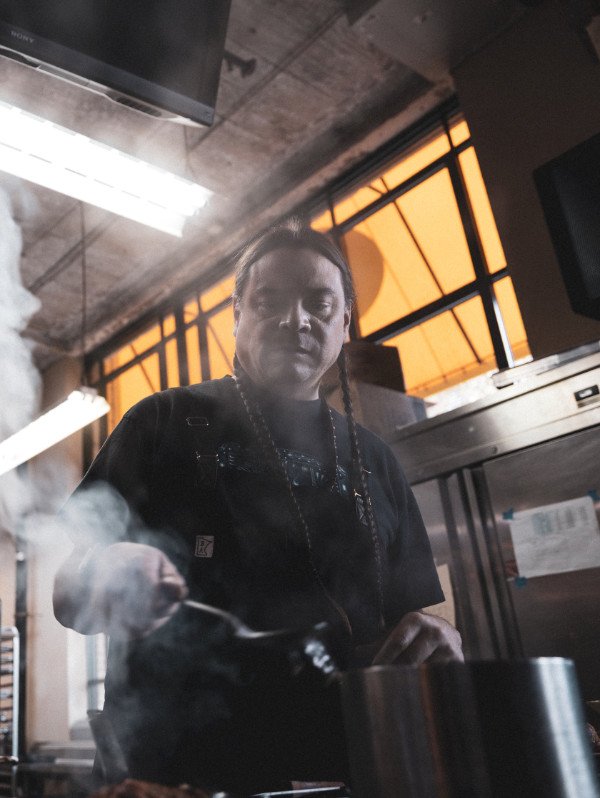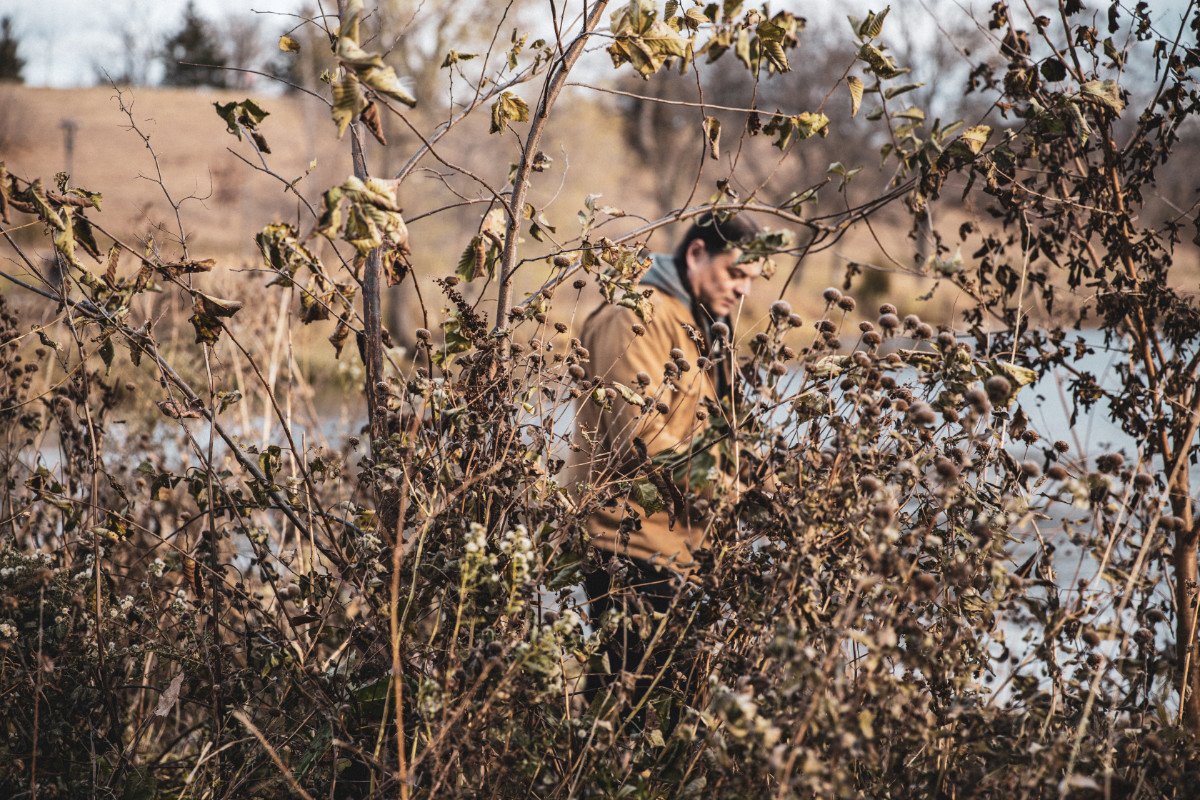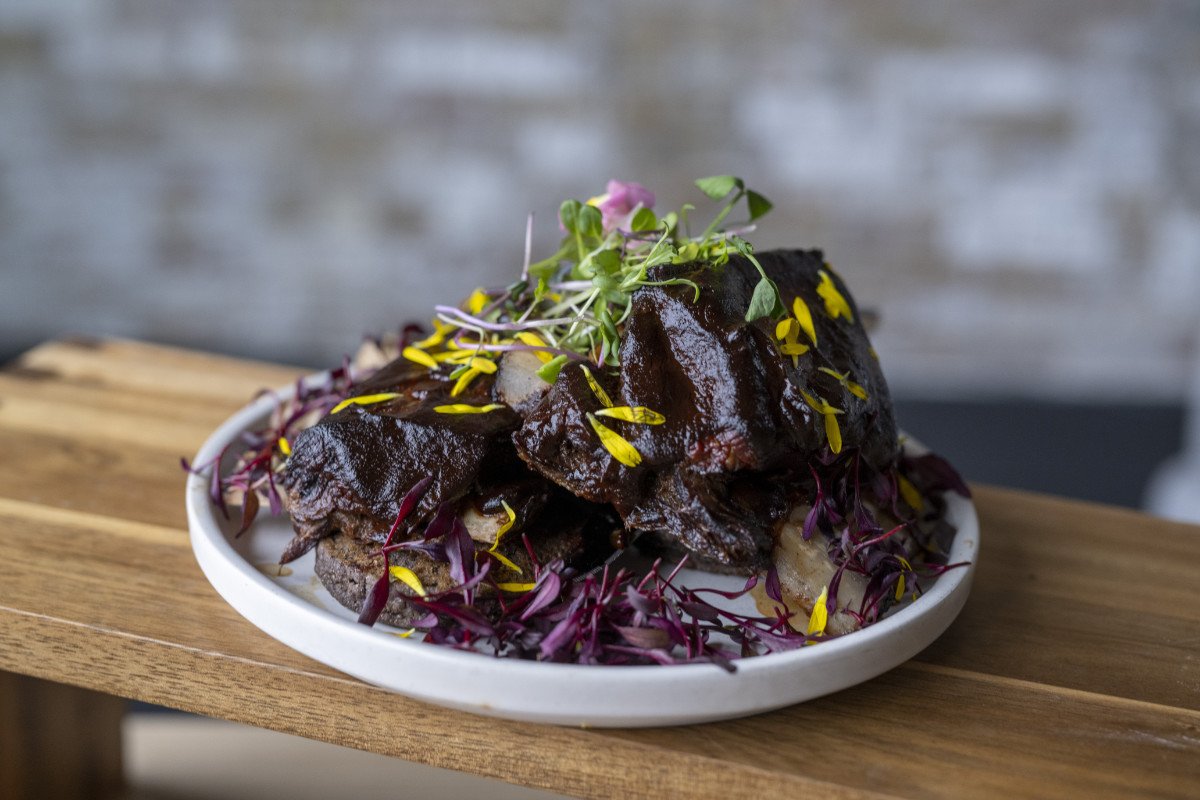The Sioux chef, known for celebrating and restoring pre-colonial foodways, launches two new Indigenous food ventures and publishes his second book.

The Sioux chef, known for celebrating and restoring pre-colonial foodways, launches two new Indigenous food ventures and publishes his second book.
May 20, 2025

Sean Sherman at his award-winning restaurant, Owamni, in Minneapolis. (Photo credit: Nancy Bundt)
Sean Sherman walks through an expansive commissary kitchen in South Minneapolis, his eyes lighting up with excitement. He isn’t taking in the kitchen as it is—dormant but well-equipped with an industrial smoker, a walk-in sausage-making area, and plentiful storage space. Instead, he’s seeing the future of his Meals for Native Institutions initiative, when the space is up, running, and realizing a long-term vision to introduce more Indigenous foods into the American food system.
Expand your understanding of food systems as a Civil Eats member. Enjoy unlimited access to our groundbreaking reporting, engage with experts, and connect with a community of changemakers.
Already a member?
Login
Sherman, an Oglala Lakota tribal member with an unassuming demeanor, a soft smile, and a signature long braid hanging down his back, has endeavored to revitalize Native American food traditions since 2014, when he founded The Sioux Chef, a catering and educational enterprise. His focus is on “decolonized” food—made without Eurocentric ingredients such as beef, pork, chicken, dairy, wheat flour, and cane sugar—most notably at his acclaimed Minneapolis restaurant, Owamni.
“We’re scaling up our efforts almost simultaneously in Minnesota and Montana, and the goal is that we’re developing a model that works anywhere.”
There he’s become known for cedar-braising bison (flavoring meat with sprigs of the coniferous tree), chopping up plant medicines like ramps, morels, and sweet potatoes, and finishing off dishes with seasonings like sumac and sage. His Indigenous Food Lab (IFL), also in Minneapolis, is an incubator and training kitchen where Native chefs and entrepreneurs can access equipment and information from Sherman and other knowledge keepers.
Sherman still cooks at his restaurant, but these days, he has his sights set on a triad of initiatives that bring him closer to the goal of making the U.S. food system more inclusive and indeed more Indigenous. The opening later this year of an Indigenous Food Lab satellite in Bozeman, Montana, is part of that vision. So too is his cookbook Turtle Island (Clarkson Potter), which I coauthored, covering Native foodways across North America.
But in this moment, Sherman is most excited about Meals for Native Institutions, which will provide schools, hospitals, penitentiaries, and community centers with large-format Indigenous foods.
“This model has such immense potential to have a huge impact on the way we eat, especially for kids and elders—and really everyone,” he says about the larger efforts to decolonize institutional food.
This year feels like a full-circle moment for Sherman, who grew up eating government commodity foods—think canned beef and neon-orange blocks of cheese—on South Dakota’s Pine Ridge Reservation. That tribal community has endured some of the most devastating impacts of European colonization and U.S. policies on Indigenous cultures, practices, and foodways, including the government-sanctioned slaughter of the all-important bison.

Sherman cooking at the Indigenous Food Lab incubator and training kitchen in Minneapolis. (Photo credit: Bill Phelps Studio)
Today, Pine Ridge has some of the highest poverty rates in the nation and lowest life expectancies in the world. For Sherman, a TIME 100 honoree and three-time James Beard Award winner, a return to Indigenous foods can address some of those marked inequities.
“Maybe down the road we’ll even be able to get some of these Native food products into the commodity food program, which so many rural Indigenous communities like the Navajo Nation and Pine Ridge still utilize today,” he added.
His mission to revitalize Indigenous foodways began with a yearning to learn more about his people’s food while also curtailing the marked health inequities tribal communities experience, including disproportionate rates of obesity, type 2 diabetes, and heart disease. He’s done this through his nonprofit, North American Traditional Indigenous Food Systems (NATIFS), and through Owamni, and now he’ll have additional ways to move toward these goals.
Meals for Native Institutions will be housed in a newly acquired space that Sherman has named Wóyute Thipi (meaning “food building” in Dakota), situated along what’s known as the American Indian Cultural Corridor on Minneapolis’ Franklin Avenue, a cultural district home to several Indigenous-owned businesses, including a coffee shop and an art gallery.
The building will serve as NATIFS’ headquarters and feature a counter-service Indigenous BBQ restaurant dubbed ŠHOTÁ—the Dakota word for smoke—that’s expected to open later this year. Like Owamni, that public-facing eatery is meant to bring more meaningful attention to his big-picture goal.
“There is a huge need for culturally appropriate foods, especially in schools and programs serving Native people.”
Although the institutional foods initiative is still in the early stages, with Sherman actively fundraising to get it off the ground this summer, he foresees the well-equipped 4,000-square-foot commissary kitchen churning out a plethora of simply prepared, nutritious Indigenous foods. Early recipes include wild rice pilaf with dried berries; baked tepary beans lightly sweetened with maple syrup; and a three sisters soup that brings together nixtamalized pima corn, tepary beans, and delicata squash.
Much like the fare served at Owamni and planned for ŠHOTÁ, the meals created for schools and hospitals will be devoid of ingredients introduced by Europeans during colonization. Sherman’s team is working closely with a nutritionist to ensure recipes will meet established USDA nutritional standards for those settings.
“We know that the menus designed for the American school system aren’t great,” he said. “For example, pizza is somehow considered a perfect food because it covers the meat, grain, dairy, and fruit and vegetable requirements all in one swoop, but we know that pizza isn’t a perfect food for schoolkids. We’re not trying to replace the entire lunch program; we’re trying to create culturally specific components so there are options to build out menus using these recipes with at least one ingredient coming from an Indigenous producer.”
Local Indigenous advocates are cheering Sherman on as he expands his purview to better serve the robust Native community in the Twin Cities, estimated at more than 35,000 individuals. “There is a huge need for culturally appropriate foods, especially in schools and programs serving Native people, and I’m grateful Sean is supporting this with his new business,” said Indigenous Food Network Program Coordinator Kateri Tuttle. “There will always be a need to continue to expand services that provide our families and community with these important foods.”

Sherman wants to introduce more Indigenous foods into the American food system. (Photo credit: Bill Phelps Studio)
As much as this is about feeding people, it’s also about uplifting Native entrepreneurs and businesses. To that end, Sherman estimates that NATIFS currently funnels some $700,000 a year to Indigenous producers and farmers. He only see that growing from here.
“We want to ensure there’s always money going toward Indigenous food production,” he said. “I think we could probably double or triple our current purchasing power with this move into institutional food, where we’ll eventually be creating thousands of servings a day. So we’re not only addressing a need, but we’re also helping create a more sustainable system.”
Muckleshoot nutrition educator and food sovereignty advocate Val Segrest, who has collaborated with Sherman on past initiatives, emphasized the importance of initiatives like this.
“Efforts like this are a powerful reclaiming of space [and] story, and strengthen food sovereignty,” she said in an email. “By establishing Indigenous-owned food hubs in the heart of our communities, we restore pathways for cultural knowledge, health, and economic vitality to thrive. This is more than a building or initiative—it’s a beacon for Indigenous food futures, rooted in our values and nourished by our ancestors’ vision.”
Sherman is also eager to launch the satellite IFL in Bozeman, developed in partnership with Montana State University’s Buffalo Nations Food System Initiative, the Montana Indigenous Food Sovereignty Initiative, and the Human Resource Development Council of Southwest Montana.
Set to open this fall, it will be located in the Human Resources Development Council of Southwest Montana building and feature an incubator kitchen, a classroom, and a large warehouse designed to replicate the model he has developed in Minneapolis. Similar satellite IFLs are in the works in Rapid City, South Dakota, and Anchorage, Alaska—all intended to empower regional Indigenous chefs, entrepreneurs, community members, and organizations with professional equipment, culinary knowledge, and other support as needed.
For Sherman’s collaborators in Montana, it’s a welcome development. “First and foremost, the Indigenous Foods Lab is about revitalizing the kinship economy for the well-being of the people and the land; in the current climate, this work is more important than ever,” said Jill Falcon Ramaker, PhD (Bishkane Mishtadim Ikwe), director of the Buffalo Nations Food System Initiative.
“In the past, our [Native] food system was sustainable for more than 13,000 years because of the networked work of Native people and reliance on the gifts of the land or our older-than-human relatives,” she said. “As we return to the land in a place-based food system, we must rebuild our community amongst Native nations in the region.”
But the impact of the forthcoming IFL goes beyond just the area’s tribal communities, explained KayAnn Miller, co-executive director of the Montana Partnership to End Childhood Hunger. She pointed to alarming state statistics that she hoped the IFL could help curtail: that about two in five Montana residents have two or more chronic diseases, and that about a third of Montana children have at least one chronic disease.

An entree from Owamni, Sean Sherman’s award-winning restaurant, featuring elk. (Photo credit: Scott Streble).
“As we know, chronic diseases often have a dietary component, which means we need to eat a whole lot better in Montana,” said Miller. “Indigenous foods—which tend to be whole and healthy with an emphasis on lean proteins and fruits and vegetables—are right in line with what we all need to eat to reduce health challenges like heart disease and diabetes, which are two of the top 10 causes of death in our state. I see the Indigenous Food Lab as a way for all of us to learn more about these good foods, how to prepare and cook them, and how to grow and eat more of them.”
For Sherman, it’s an opportunity to address the inequities he grew up with back on the Pine Ridge Reservation while also uplifting local Native communities.
“We’re scaling up our efforts almost simultaneously in Minnesota and Montana, and the goal is that we’re developing a model that works anywhere—the Dakotas, Alaska, Hawaii,” he said. “Not only does this give Indigenous communities a platform to talk about the true histories of their cultures and these lands, but it’s also building skills and creating jobs within our communities. This is the kind of food sovereignty we’ve always been working toward.”

July 30, 2025
From Oklahoma to D.C., a food activist works to ensure that communities can protect their food systems and their future.
Leave a Comment